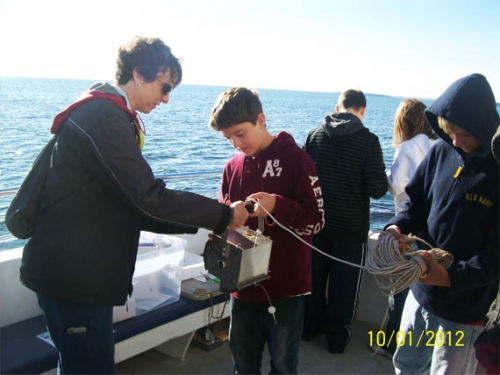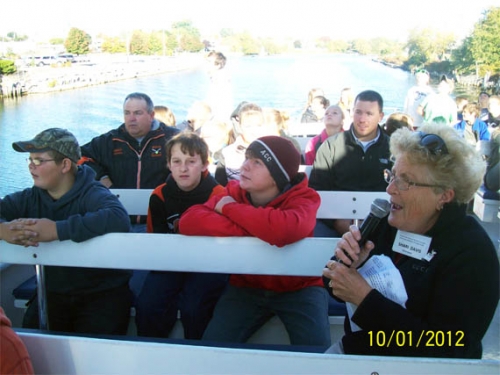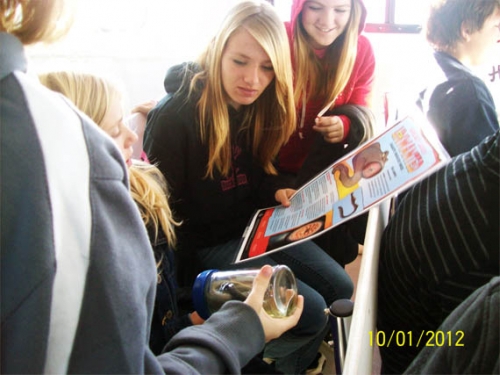Rogers City students kick-off Trout River Watershed study
Rogers City Middle School students voyage out into Lake Huron to kick-off their yearlong efforts to monitor water quality, health of local Trout River – an enjoyable learning experience providing valuable water quality data for their community.
A Memorable Learning Experience!
On October 1, Holly Wirgau’s Rogers City Middle School students voyaged out on Lake Huron aboard the Lady Michigan. Their mission was
to explore Great Lakes water quality, fisheries and aquatic ecosystems, maritime heritage and how people connect with Michigan’s water resources. This
on-the-water experience launched a yearlong place-based watershed study centered on their local Trout River Watershed. In just one year, students will
be raising salmon, wading in the Trout River, and making Great Lakes connections with their inland water  study that began with a trip out on Lake
Huron aboard a glass-bottom boat!
study that began with a trip out on Lake
Huron aboard a glass-bottom boat!
Applying place-based education principles as part of her educational programming, Wirgau recognizes her educational programming is not about individual projects, but rather her yearlong program of engaging youth with their local water resources, fostering strong school and community partnerships, and tying her projects through the year with the goal of complementing school improvement and her own curricular teaching goals.
Getting StartedYears ago, when Rogers City Middle School teacher, Holly Wirgau, started participating in the Michigan Dept. of Natural Resources (DNR) Salmon in the Classroom, she wasn’t expecting it to turn into something much larger. However, once she began connecting her students to local environmental issues, it only made sense to broaden the scope and develop additional projects through her growing community partnerships.
 Through her involvement with Michigan Sea Grant, 4-H Youth Programs, and the Northeast Michigan Great Lakes Stewardship Initiative (NE MI GLSI) network,
she had the opportunity to build off the concepts she was already teaching with the Salmon in the Classroom program. Her idea was to use an outdoor, hands-on
approach to help her students learn about the river habitat of Salmon and other fish. Studying water quality – how to measure it and what affects it has on
habitat – provided the perfect opportunity for Wirgau to incorporate place-based education practices in growing her science class projects into a yearlong
educational program.
Through her involvement with Michigan Sea Grant, 4-H Youth Programs, and the Northeast Michigan Great Lakes Stewardship Initiative (NE MI GLSI) network,
she had the opportunity to build off the concepts she was already teaching with the Salmon in the Classroom program. Her idea was to use an outdoor, hands-on
approach to help her students learn about the river habitat of Salmon and other fish. Studying water quality – how to measure it and what affects it has on
habitat – provided the perfect opportunity for Wirgau to incorporate place-based education practices in growing her science class projects into a yearlong
educational program.
Learning through their Project
With funding and professional development support from the NE MI GLSI, Wirgau was able to connect with community partners and get her students outside and connected to the local Trout River to study and monitor the quality of the water. Testing chemical properties, such as pH and dissolved oxygen, allowed the students to build off their previous chemistry knowledge. After all, the process for testing these properties teaches students the same skills learned in chemistry labs conducted in the classroom.
The students are also using macroinvertebrate studies to help them better understand the ecology of the aquatic ecosystem. For example, different species of small aquatic organisms are found in different water habitats, so sampling and identifying these species is an incredibly useful way to determine water quality. In doing so, students learn how to use dichotomous keys to identify species, while realizing living organisms flourish in many shapes and sizes.
Community Connections
Capitalizing on water-related GLSI networking and professional development opportunities,
her educator team has benefited from a wealth of curriculum and resource support for her program. Supported previously by the Toyota
4-H20 program and now also by the NOAA BWET program, her team has received curriculum training, as well as Great Lakes and water education resources, provided through Michigan Sea Grant and other water
education-interested partners. Leveraging these community partnerships, Wirgau’s class has also received funding from partners to secure water testing equipment
needed to accomplish their water quality monitoring objectives. These community connections are valuable in buildi ng and sustaining her educational program,
yet also serve a benefit to partners investing in her students who contribute back to their community through their stewardship projects.
ng and sustaining her educational program,
yet also serve a benefit to partners investing in her students who contribute back to their community through their stewardship projects.
In a river where no water quality monitoring had previously been conducted, Wirgau’s middle school science students were able to collect important new data. Working with community partners, such as the Presque Isle County Conservation District and the Presque Isle County Drain Commissioner, the students were able to learn from the experts while also providing them with valuable information they do not have time to collect themselves. With the help of these students, the Rogers City community now has some baseline data about the Trout River, to which they can refer in the future, something that likely never would have happened without the help of this educational effort.
For more information about the Northeast Michigan Great Lakes Stewardship (NE MI GLSI) Initiative and place-based, community-based education programming partnerships with Rogers City Schools, visit the NE MI GLSI website and Rogers City Middle School’s project page.



 Print
Print Email
Email


